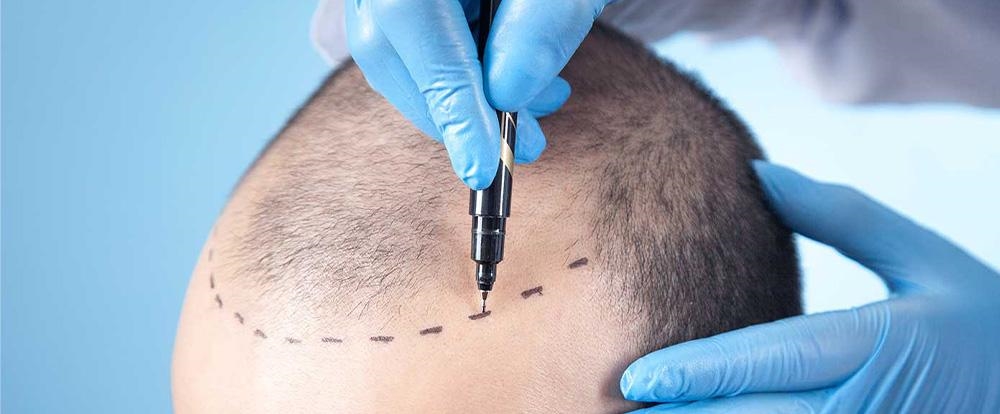Hair Transplantation

Overview
Hair development begins in the intra-uterine life and continues throughout the person's life span. Although hairs are thin and light-colored in the uterine life, they start thickening and darkening after birth. There are about 100 thousand hair follicles in the scalp of an infant.
Our hair grows for a certain period and sheds, but hair follicles replace them. Although there are interpersonal variations, 80 to 120 hair strands may shed every day, resulting from the ordinary life cycle of body hairs. Each hair strand progresses through growth, resting, and shedding phases.
Hair loss is considered when hair gets thin when more than usual hair sheds while combing and bathing, and when the front hairline recesses.
Numerous factors play a role in hair loss, including but not limited to genetic predisposition, exposure to chemicals and drugs, psychological stress, skin diseases, systemic diseases, hormonal disorders, surgical procedures, improper hair care, and insufficient nutrition. One or more than one of these factors may be responsible for the hair loss, although it is possible to fail to identify an underlying cause.
Moreover, hair loss can be reversible or irreversible. Hair growth may be sustained after the underlying cause (e.g., stress) is eliminated for irreversible cases. The type of hair loss is also essential. Male-type (androgenetic) hair loss is the most common type in men and women. This type of hair loss results from genetic and hormonal factors, while trauma, medications, and diseases have no role. This type of hair loss is scarce in women.
Another type of hair loss is the development of patchy bald areas on the scalp. An immune system abnormality is accused in this disorder, called "alopecia areata" in medical terminology. It may be irreversible, but it is also possible for hair to grow again. The other type of hair loss is generalized hair loss. This condition is caused by a factor that damages the hair follicles throughout the body (for example, drugs, stress, thyroid gland diseases, other hormonal disorders, insufficient nutrition, and significant surgeries).
Package Includes
1. Medical Procedure: Physician First Examination – Pre-operativeHair transplantation FUE method with guaranteed Maximum Graft TransplantationMicromotor grafts extractionLocal anesthesia medicationsPostoperative inspection by your doctor 7/24 open emergency line
2. Hospital Facilities: Hair Transplantation Room Usage
3. Accommodation: 2 Nights Hotel Accommodation 4-5 Stars – (Bed Breakfast – 1 Person)
4. Transports: All transfers between the airport, hospital, and hotel
Why is a Hair Transplantation Procedure Done?
Since the underlying factors of hair loss cover a broad spectrum, several treatment options exist, including hair transplantation.
Excluding androgenetic or male-type hair loss, the underlying cause must first be investigated. After the underlying cause has been identified, treated, or eliminated, your doctor may offer to wait for hair re-growth. You can improve your appearance in this period by wearing a bandana or hat, make-up, and a wig. If it is considered that the hair loss is reversible, medicines, such as Minoxidil, medication, nutritional supplements, and acupuncture, which support and accelerate the growth of the hair, can be tried. In addition, healthy eating, proper hair care, hair care products, and avoiding hair dyes and perm that contribute to hair loss can alleviate or stop hair loss.
Recently, hair mesotherapy has also given promising results in the selected patients. Finally, platelet-rich plasma (PRP) is a treatment that re-grows the hair. Blood is drawn from the person, subjected to a unique process, and the resultant solution is injected into the bald area. The aim is the re-growth of hair by nourishing the hair follicles. PRP can be used alone or in combination with mesotherapy.
However, hair transplant is the definitive treatment for androgenetic hair loss and other forms of hair loss caused by factors that lead to irreversible damage of hair follicles, such as chemotherapy, radiotherapy, scalp infections, burns, and major surgeries.
However, there are also conditions that hair transplantation does not help. First, the donor should have a sufficient number of healthy hair follicles. Moreover, extra pre-transplant procedures may be required, or hair transplantation may not be possible in cases such as burns, as the scalp does not allow hair transplantation. If no condition contraindicates the hair transplantation, the "natural looking" solution will be provided by hair transplantation.
Before Hair Transplantation
• Don't use aspirin, B and E vitamins, and other similar medicines one week before the operation
• If you drink alcohol, don't drink Alcohol 3 days before the operation
• Do you have an allergy to drugs? Please inform your doctor at the consultation in the hospital
• Do not smoke 24 hours before the operation if possible. Don't forget that smoking will extend the convalescence time
• If you're using the medicine for chronic (diabetes, heart disease, blood pressure, tuberculosis, etc.) or acute illnesses, you must inform your doctor at the consultation in the hospital
• Bring a comfortable button-front shirt and sweatpants with you
• Before the operation, do not use any gel or sprays after
• Please bring comfortable clothes with you. Button-down front garments should be worn for the hair transplant.
Preparation
The preparation phase of hair transplantation instead aims to determine whether you are a good candidate for hair transplantation.
Your health history, medications (prescription and over-the-counter), and all vitamins and food supplements are reviewed, and blood and urine tests are analyzed to investigate the underlying cause of hair loss.
The time elapsed since the onset of hair loss, the thickness of the hair, type of the hair loss (androgenetic, generalized, alopecia areata), history of hair loss and whether hair grew again, if the same condition developed in the past, and factors that increase hair and worsen the hair loss are carefully addressed. If your doctor deems it necessary, the scalp is biopsied, and the scalp and hair follicles are examined under a microscope. After it is determined that the hair transplant is the best choice for your condition, you should inform your doctor about all your expectations to avoid disappointment after the procedure.
Risks
If you carefully follow the recommendations and instructions of the doctor who will perform the hair transplantation, the risk of complications after hair transplantation is almost zero.
Surgery and early postoperative period
After the final decision of hair transplantation is made, the donor area, where hair follicles are harvested, and the recipient area, where hair follicles are transferred, are drawn, and a plan is made before the procedure is initiated. Local anesthetic agents will be administered to relieve or eliminate discomfort during hair transplantation.
Today, there are two hair transplant techniques, namely FUE and FUT. However, the most commonly preferred technique is Follicular Unit Extraction (FUE). Follicular Unit Transfer (FUT) is the other method that was more widely used in the past, but it is not a standard method nowadays due to scar formation and the requirement of stitching.
The FUE method has two subtypes, Conventional and No Shave FUE, according to whether the area where hair follicles are transferred is shaved. The only difference between No Shave FUE and conventional FUE is that the donor and the recipient areas are not shaved or they are cut short. In addition, if deemed appropriate, your doctor may recommend combining the FUE technique with PRP and hair mesotherapy.
In the FUE method, hair follicles can also be harvested from other parts of the body if the hair follicles on the scalp are insufficient for hair transplantation. On the other hand, the FUE method effectively treats hair loss in eyebrows, mustache, and beard.
The donor and recipient areas are cleaned and prepped in the FUE technique. After the scalp is drawn to plan the transplantation, photos of the scalp are taken to make comparisons. Hair follicles are harvested from the nape, where hairs are genetically resistant to hair loss, using special thin needles measuring ≤1 mm in diameter. FUE technique does not require incision on the scalp, while hair follicles (graft) are collected; therefore, no scar tissue forms. The hair follicles are prepped to be transferred. Very tiny holes are drilled at the recipient area using a micromotor device. These canals or holes are trained in the direction of hair growth; thus, your hair will look natural when it grows after hair transplantation. The scalp is closed with a bandage after hair follicles are transferred per the pre-transplant plan and drawings. The hair transplant procedure takes about several hours.
The procedure can be completed in the second session the next day if necessary. You may feel mild redness and discomfort after the procedure. Usually, these conditions do not require treatment, but your doctor will inform you about issues that need your attention, and you will also be given an information procedure. You should avoid strenuous activities for 15 days and protect the scalp against traumas.
Your doctor will probably ask you to visit the hospital one day after the procedure. The bandage will be removed during this visit.
If you experience the warmth and remarkable pain at the donor or the recipient site, if you have a fever, or any symptoms that you think are due to the hair transplant after you are discharged, contact your doctor immediately.
Results
Hair will grow, but it will shed quickly after the hair transplant. You can see hair growth by transferring hair follicles approximately two months later. Your hair will generally grow, and the baldness will be eliminated about six months to one year later.




















